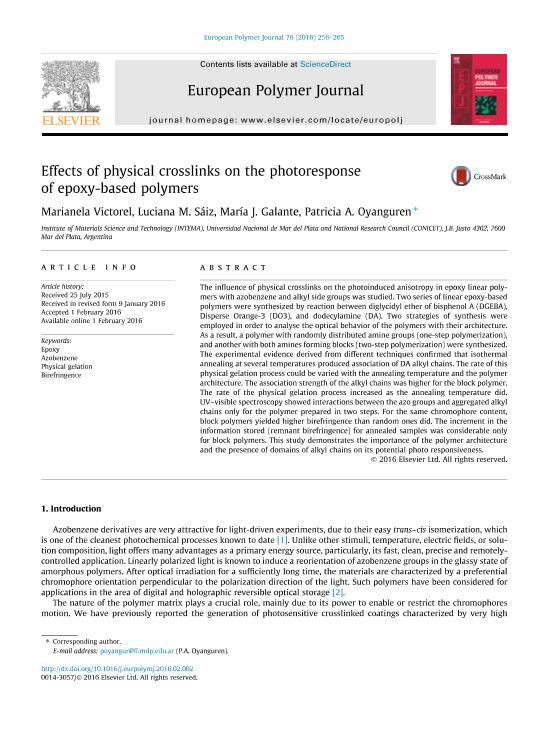Artículo
Effects of physical crosslinks on the photoresponse of epoxy-based polymers
Fecha de publicación:
03/2016
Editorial:
Pergamon-Elsevier Science Ltd
Revista:
European Polymer Journal
ISSN:
0014-3057
Idioma:
Inglés
Tipo de recurso:
Artículo publicado
Clasificación temática:
Resumen
The influence of physical crosslinks on the photoinduced anisotropy in epoxy linear polymers with azobenzene and alkyl side groups was studied. Two series of linear epoxy-based polymers were synthesized by reaction between diglycidyl ether of bisphenol A (DGEBA), Disperse Orange-3 (DO3), and dodecylamine (DA). Two strategies of synthesis were employed in order to analyse the optical behavior of the polymers with their architecture. As a result, a polymer with randomly distributed amine groups (one-step polymerization), and another with both amines forming blocks (two-step polymerization) were synthesized. The experimental evidence derived from different techniques confirmed that isothermal annealing at several temperatures produced association of DA alkyl chains. The rate of this physical gelation process could be varied with the annealing temperature and the polymer architecture. The association strength of the alkyl chains was higher for the block polymer. The rate of the physical gelation process increased as the annealing temperature did. UV-visible spectroscopy showed interactions between the azo groups and aggregated alkyl chains only for the polymer prepared in two steps. For the same chromophore content, block polymers yielded higher birefringence than random ones did. The increment in the information stored (remnant birefringence) for annealed samples was considerable only for block polymers. This study demonstrates the importance of the polymer architecture and the presence of domains of alkyl chains on its potential photo responsiveness.
Palabras clave:
Azobenzene
,
Birefringence
,
Epoxy
,
Physical Gelation
Archivos asociados
Licencia
Identificadores
Colecciones
Articulos(INTEMA)
Articulos de INST.DE INV.EN CIENCIA Y TECNOL.MATERIALES (I)
Articulos de INST.DE INV.EN CIENCIA Y TECNOL.MATERIALES (I)
Citación
Victorel, Marianela; Sáiz, Luciana María; Galante, Maria Jose; Oyanguren, Patricia Angelica; Effects of physical crosslinks on the photoresponse of epoxy-based polymers; Pergamon-Elsevier Science Ltd; European Polymer Journal; 76; 3-2016; 256-265
Compartir
Altmétricas




